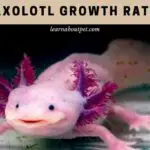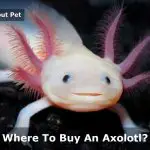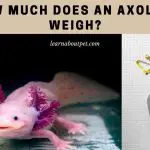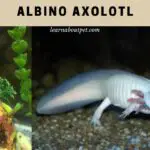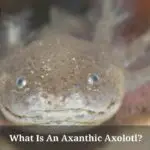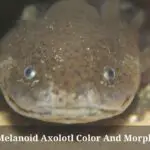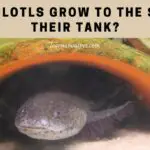Axolotls have recently caught human compassion because they are considered extinct in the wild. As more and more enthusiasts are adapting axolotls as pets, new and reliable information about their habits and food, in particular, is becoming common.
Baby axolotls grow very fast in the early stages, needing a lot of energy. For this, it is recommended to be fed one or two times a day. Adult axolotls can be fed once every 2 to 3 days. Young adults who are still growing still need to be fed once a day.
This article is about baby axolotls, especially baby axolotl care. We will discuss the food, habitat, and other related questions to baby axolotl care.
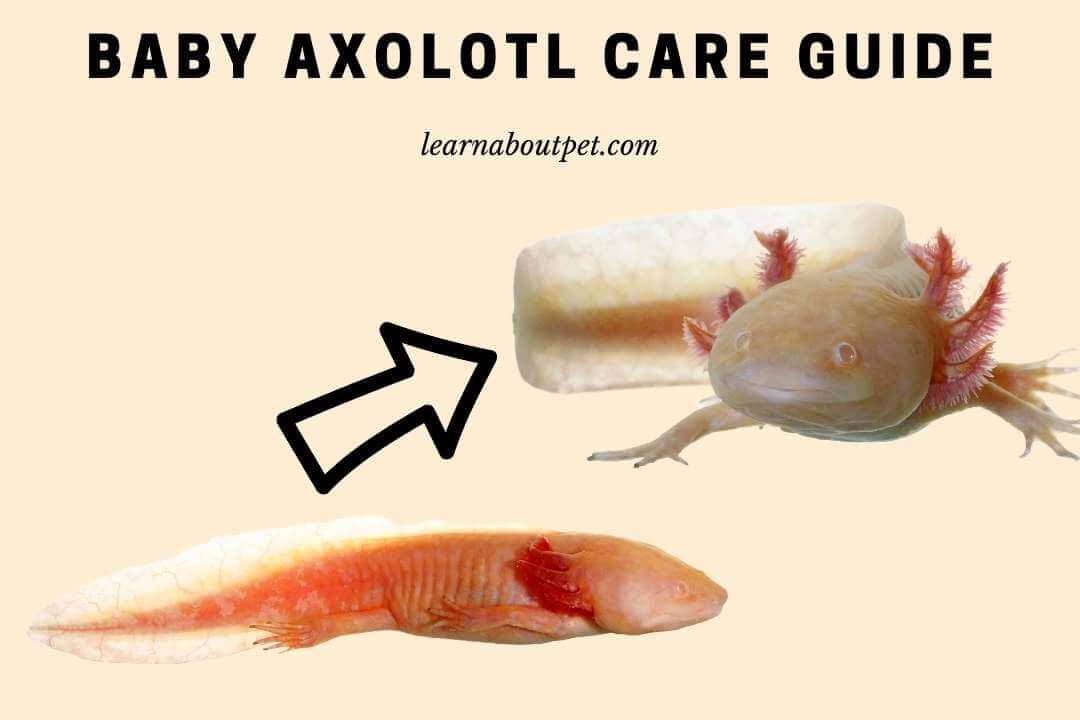
Hope you enjoy our study and get all the answers concerning baby axolotl care.
How Do You Feed A Baby Axolotl?
Proper feed is a very important part of baby axolotl care. Newly hatched baby axolotl is not fed for the first 24 to 72 hours. They don’t move and only consume the embryo sac. After this period live food in the shape of small worms is fed.
The newly hatched larvae cannot search and swim for food. For this, the feed has to be placed close to their mouth. They will only eat live feed, moving in front of them.
They have not learned to dash for the feed when placed or dropped in their tank. For this, the feeding tank should not be very large and the water in the tank or container should be shallow to help in feeding.
People use a turkey baster to place food directly in front of the baby axolotl’s mouth. The baby axolotl sucks the feed into their mouth by vacuum.
The feed recommended for baby axolotl care is baby brine shrimp, microworms, small daphnia, mosquito larvae, underwater bugs, and whiteworms.
The food morsels have to be in very small form, as the baby larvae itself is less than half an inch in length.
All unconsumed food should be removed soon after feed time as rotten food will spread bacteria, which would not be good for the health of the axolotl.
What Do Baby Axolotls Need?
Baby axolotl care is somewhat different from adult axolotls. Axolotl baby age is considered from hatching (birth) till it grows to about 20 mm (just under 1 inch in length). This is roughly 2 weeks.
Baby axolotl care is special because they are very sensitive to water temperature fluctuations, water quality and conditions, and the amount of oxygen in water.
Axolotl babies die quite frequently during the first few weeks. Genetics and infection from the tank water are considered the two major factors for this.
Below we highlight some important steps recommended for how to take care of a baby axolotl.
Aquarium
Baby axolotls are small creatures and grow rapidly from about half an inch at birth to one inch in just two weeks when proper diet and environment is provided. After that, they need to be separated because of their cannibalistic properties.
For this plus other reasons, pet owners prefer to keep baby axolotl tank size small.
The young hatchlings are put in small glass jars or plastic containers or tubs. The larvae need frequent water changes, as they produce a lot of waste.
A simple container with no substrate is best. The water temperature must be controlled. In this case, the ambient room temperature must be in the required range, as the water in the small tank will easily attain room temperature.
Aeration
Supply of oxygen in the water is required for the larvae stage of the baby axolotl care. Baby axolotls use gills for breathing oxygen in water. At a later stage, they develop lungs.
Air is pumped through a small low-pressure blower to feed oxygen through an air stone placed inside the water.
After 3 weeks, when the baby axolotls can move freely, there is no need for an air bubbler. Daily clean and fresh de-chlorinated water is required.
Water temperature
Be it the baby axolotl care, a juvenile or an adult, proper temperature range of their water habitat is critical for the growth and survival of the axolotl.
Even a few degrees of a sudden change in water temperature can be fatal for the baby. Chlorine-free freshwater is recommended for their habitat. The axolotls thrive in somewhat cold water.
The ideal water temperature for baby axolotl care is around 68-72°F (20-22°C). This is considered the optimum temperature for the rapid growth of the baby axolotl.
It must be remembered that the small amount of water content in the gar, will acquire the room temperature quickly, hence a room with a constant temperature is necessary.
Water changes
Provision of water with the right parameters is a must for the baby axolotl care. The water in the baby axolotl container should be replaced 100% daily.
Baby axolotl larva should get fresh de-chlorinated water at 68 – 72°F (20 – 22°C). The pH of water should be 7.4 to 7.6 (slightly basic).
The best time is to change water after feeding time, as this will clean the habitat of all unwanted stuff (dead food particles and refuse) and make the environment healthy.
Pet owners have the clean and treated water available all-time in a separate bucket in the same room, so it is always at the right temperature.
Feeding
Proper feed and frequency are as important in baby axolotl care as other factors like water quality, water temperature, water changes, and aeration.
Because the baby axolotl grows quite rapidly, the normal yardstick for measurement is the physical size and physical features rather than the age in weeks or months.
The dietary requirements of baby axolotl are quite different from adult axolotls. The feed is adjusted to the baby larvae size.
Just after birth for 24 to 72 hours the newborn will not move and eat nothing. It will consume the proteins in its body which is carried from its embryo stage.
After this time, baby axolotls are fed only live food, because they can recognize only moving or wiggling things, which they will grab, thinking it as their feed.
As the baby axolotl larvae are only half an inch in size, they must be fed very small morsels of the food.
Their first diet will comprise of some freshly hatched baby brine shrimp (BBS), cultured daphnia, microworms, and chopped blackworms. Not all baby axolotls will eat the same food. Try different varieties.
Baby axolotl care requires that they be fed once or twice a day. As baby axolotl are growing, their metabolic rate is much higher than the adult axolotls
Feed them for about three minutes maximum. If they do not show any interest, do not try to overfeed them.
Feed them with a variety of foods, so all axolotls have an opportunity to have equal growth.
One of the important things for feeding is to keep their water clean all time. All surplus food should be removed immediately after feed time.
Rotting and decomposing food will produce bacteria, which will make the axolotl sick.
Separating
As each baby axolotl will have different temperaments of eating and due to other factors, their growth pattern would be different. The front legs start to develop in 2nd week and are fully developed in the baby stage.
By this time it is noted that the baby axolotls develop cannibalistic traits. This is thought of due to their instinct of considering any moving thing as prey for food.
Missing limbs and gills of baby axolotls in a common habitat could be the result of this.
It is a good idea to separate them by size when they are about 2 cm in size (about ¾ of an inch).
By segregating the larger axolotls you can easily feed them other diets more suitable for that size like salmon pellets, earthworms, etc.
How Hard Is It To Take Care Of A Baby Axolotl?
Baby axolotl care is relatively easy as compared to other pets. Their sensitivity is only to the water temperature and its quality and their feed.
The water has to be kept at the right temperature and changed regularly so it is fresh all-time with oxygen bubbled through.
The tank should be cleaned regularly as any bacteria or parasites can affect the axolotls, as with other pets. Do not overcrowd the tank with baby axolotls.
The small size of the water tank makes it easy for daily maintenance like cleaning and change of water. In fact, pet lovers keep duplicate tanks to have ease in handling.
What Temperature Do Baby Axolotls Need?
One of the difficult parts of baby axolotl care is maintaining an even temperature of the jar water. The best temperature for baby axolotl growth is considered to be 72°F (22°C). Use an aquarium chiller for Axolotl to live comfortably in their tank and grow.
There should not be large and sudden variations in the temperature.
As the axolotl habitat (jar) is not very big and only has a small quantity of water, it will soon acquire the temperature of the room. So the best is to maintain room temperature.
Do Baby Axolotl Bites Hurt?
While discussing baby axolotl care, pet owners are intrigued to know if a baby axolotl can also bite.
An adult axolotl has very small teeth, one may not be able to see them. A baby axolotl naturally will have very small teeth. They are not meant to chew food, rather they are there just to grasp food.
A baby axolotl bite is harmless, one will just feel a little pinch. Many times pet owners report the axolotl biting their finger by mistake while feeding them by hand. One should be careful because the axolotl carries salmonella bacteria.
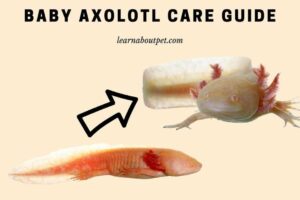
How Many Times A Day Should You Feed A Baby Axolotl?
One of the many questions for baby axolotl care is how many times in a day the baby axolotl should be fed.
Baby axolotl feed requirements are different from an adult axolotl. The baby needs to be fed one to two times a day as it is rapidly growing and needs a lot of energy.
Just to be sure of not overfeeding it, feed for a couple of minutes, and if it is not interested, do not feed more. Do not leave the leftover food in water, assuming the axolotl will eat it later.
Remove all surplus food immediately as it will foul the water and will contribute to bacteria and health problems for the baby axolotl.
Do Axolotls Eat Their Babies?
Yes, adult axolotls will eat their babies and eggs. It is just natural, they have a mild cannibalistic trait. This is only out of hunger they do this.
During baby axolotl care the owner has to remove the eggs from the parents immediately after laying is over (it could be over 1,000 eggs).
In a word, yes. Axolotls are carnivores and they do eat their young. Parent Axolotls may eat both Axolotl eggs and Axolotl babies by mistake. So, it’s better you separate them and keep them in separate tanks once they are born. Baby Axolotls will thrive alone and don’t need to be in the same tank as parent.
The young axolotls (called larvae) eat invertebrates, such as brine shrimp, worms, and insects. The adult axolotls eat mice or fish.
The parents are still the ones that lay the eggs. But after they do this, they do not have any more to do with larvae. In fact, sometimes the parents will even move away from where their babies are kept so that they don’t accidentally eat one.
It is very rare for axolotls to eat their young on purpose even if they are kept in a tank with no other food available. The babies do not taste that good and the parents try not to eat them as much as possible. They will usually only be eaten if the tank where they are kept has nothing else to feed them.
This is an example of a type of animal behavior called filial cannibalism . This means that the animals eat their young. It was actually quite common in the distant past but it happens less and less these days. (It still does happen occasionally, however.) Some animals will consume their own young only when there is not another source of food available.
And this can be seen in nature as well. In fact, some species of birds and fish will eat their babies if the food supply is scarce. It is just what they do to survive and it is not a sign that something is wrong with them or with how you are taking care of them.
It has been observed in captive axolotls, which are a popular choice as pets in parts of Europe and North America. The research was published in the journal Herpetology Notes.
Can I Hold My Baby Axolotl?
Another question pet owners would like to know in baby axolotl care is can they handle their baby axolotl. There are many reasons for not handling the axolotl especially baby axolotl.
First, the axolotl does not like to be handled at all. They are not societal animals. Easily get frightened and take a flight. Some pet owners report being able to touch them easily.
Second, they have delicate and permeable skin. Their bodies are mostly made of cartilage rather than bone. Because of their soft bodies, it is not advisable to handle them.
They should be handled only by a soft net. Only in a medical emergency, they may be handled.
Do Baby Axolotls Really Smile?
The smile as described is actually the shape of the baby axolotl’s mouth when it swallows its food. They just suck in their food by opening wide their mouth and after closing, it forms that curve of a smile from one end to the other.
Do Baby Axolotls Need A Bubbler?
There are different views on this topic. Axolotls breathe through their gills like fish and also through their skins, known as cutaneously. Axolotl eggs definitely need oxygen from water.
For this reason, some specialists are of the view that baby axolotl care and baby axolotl eggs require that water should be aerated by blowing in air through an air stone.
Care should be taken not agitating the water too much to stress the baby axolotls, as they are very small and lightweight.
Others argue that there is no need for a bubbler, as frequent water changes (during the larvae stage) keep the right amount of oxygen available all time.
However, adult axolotls develop rudimentary lungs, which they fill up by surfacing when they feel short of oxygen.
For these reasons, a bubbler is not recommended for adult axolotls. The filter is enough to clean the water and also aerate same time if the tank size is large enough.
A bubbler may be required if the axolotl is large compared to its recommended tank size.
How Fast Do Baby Axolotls Grow?
The eggs hatch in about 21 days after laying. The first stage of axolotl hatchlings is the newborn larvae about one centimeter long (less than a half-inch), with no limbs.
With proper feed and environment conditions, that is water temperature and quality, the fresh axolotl hatching will grow another centimeter in a week.
The Baby axolotl size will grow to an average length of 12 inches (30 cm) as an adult in about the same number of weeks. Roughly can be said in 6 months it matures to a young adult.
It does not grow beyond that. They are reported to live up to 10 to 15 years in captivity.
How Much Does A Baby Axolotl Cost?
A baby axolotl price varies anything from around $30 to $75, depending on where you are getting it from. The price range is for health, size, and color, etc. Rare variety may cost $100 or more.
Baby Axolotls can be purchased from pet stores, breeders and also over the internet. It really depends on where you buy them and how rare they are. You should look around carefully before buying your Axolotl, because not all of them are healthy.
How Often Should You Feed A 6 Month Old Axolotl?
It is generally agreed that young or juvenile axolotl should be fed only 2 to 3 times a week. Just feed them for about 3 minutes, whatever they can eat in this time.
A simple method to know if the axolotl is full is to compare its belly to the head. If the belly is getting wider than its head then he is being overfed. If it is smaller, then you can feed more.
When you feed them, you will need to give them just enough food to last for 24 hours. Because if you overfeed they may end up getting sick or die so fast. And it is also very important that your Axolotl stays well fed at all times.
A lot of people say it’s better to feed them in the morning because they may overfeed themselves at night. But, this really depends on your Axolotl and what they prefer.
Can Baby Axolotls Live Together?
As a general rule of baby axolotl care, one may keep two baby axolotls together if they are the same size. The likelihood of nipping will always be there.
Axolotls up to the age of 6 months are naturally cannibalistic. They will try to bite each other, whenever hungry. They must be kept well fed at all times to prevent this.
If there is an appreciable difference in size then there is the likelihood of the bigger one devouring the smaller axolotl.
How To Care For Axolotl Eggs?
Besides the regular questions regarding baby axolotl care, enthusiasts also are eager to know about axolotl egg care.
The female axolotl will lay up to or more than 1,000 eggs in clumps, after fertilizing with the male spermatophores. The female should be transferred to another tank immediately, as she could eat the eggs.
There is only a 10% chance of hatchlings surviving from this lot. The eggs should be transferred to other shallow smaller tanks holding no more than 50 embryos.
Remove the clumps, lay them flat on the tank bottom for hatching. Remove excess jelly, which is clumping the eggs.
You can easily know which embryos are developing and which are slow in developing. You can start the selection of the embryos at this stage, which would be hatched. Discard the dead axolotl eggs.
This is also the time you can offer these axolotl eggs for sale.
The water should be chlorine-free, at the right temperature of 64 to 68°F (18 to 20°C), and aerated to have a high level of oxygen.
Do not place the eggs in sunlight. Always assure the water is clean and aerated and the right temperature. You may need to change the water every day to achieve these parameters.
How To Hatch Axolotl Eggs
Aside from the baby axolotl care, pet owners also want to know how to raise axolotl eggs, as the delivery of 1,000 eggs one time and their handling seems an unsurmountable task.
Separate the eggs which you want to hatch. About 50 eggs are enough which can be controlled in one shallow tank.
Spread them out flat on the bottom so each embryo has an equal chance to receive oxygen and develop. Clumping prevents this from happening.
As a result embryos in the interior of the clump will develop very slowly. Use forceps to separate and remove excess jelly binding the eggs.
Axolotl egg development time is dependent on the water temperature. In warm water 77°F (25°C), hatching will start in 14 days, while in cold water 64°F (18°C) hatching will start in 20 days.
Besides the temperature, the water should be chlorine-free and aerated to have a good level of oxygen. When the babies hatch they do not move and eat for up to 3 days.
The surplus jelly can be removed and the hatched larvae transferred to another clean water tank.
Keep the protein feed of live worms like cultured daphnia, freshly hatched baby brine shrimp (BBS), microworms, and chopped blackworms ready to start feeding them after this time.
Final Verdict On Baby Axolotl Care
Axolotls are very special creatures adapted by many pet lovers as they are easy to maintain, with few requirements for their habitat.
Special baby axolotl care is required only during their infancy. Due to diseases and some genetic defects, a lot die in the larvae stage. The baby axolotl care includes clean and cold water and special feed of worms.

They grow at a very fast pace, almost a centimeter a week. The larva is just 1 centimeter (less than ½ inch) in length and grows to an average of 30 centimeters (nearly 12 inches) in that many weeks.
Once they grow to adult age in 6 months, the only requirement is for an even and relatively cold water temperature and feed of worms.
In captivity, an axolotl can live up to 15 years, when properly taken care of.

Welcome to Learn About Pet. My name is Rajkumar Ravichandran and I love all pets, travel, and amazing food. I write about my passion and personal experience caring for multiple pets in this blog! ❤️
Post Disclaimer
DISCLAIMER: THIS BLOG OR WEBSITE, "Learn About Pet", DOES NOT PROVIDE YOU WITH MEDICAL ADVICE AND IS NOT A SUBSTITUTE FOR MEDICAL ADVICE. ALWAYS GET IN TOUCH WITH YOUR PERSONAL VETERINARIAN AND USE INFORMATION HERE AS GENERAL ADVICE.
The information, including but not limited to, text, graphics, images and other material contained on this website are for informational purposes only. No material on this site is intended to be a substitute for professional veterinary advice, food recommendation, diagnosis, or treatment. Always seek the advice of your veterinarian or other qualified health care provider with any questions you may have regarding a medical condition or for pet food related questions.
